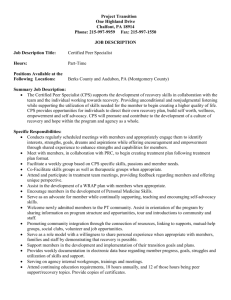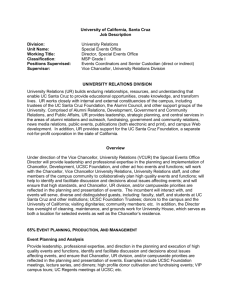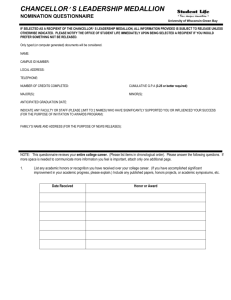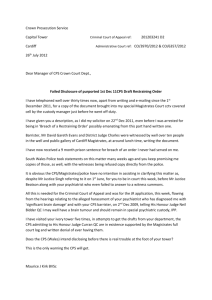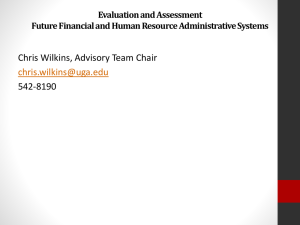Project Summary Procedure
advertisement
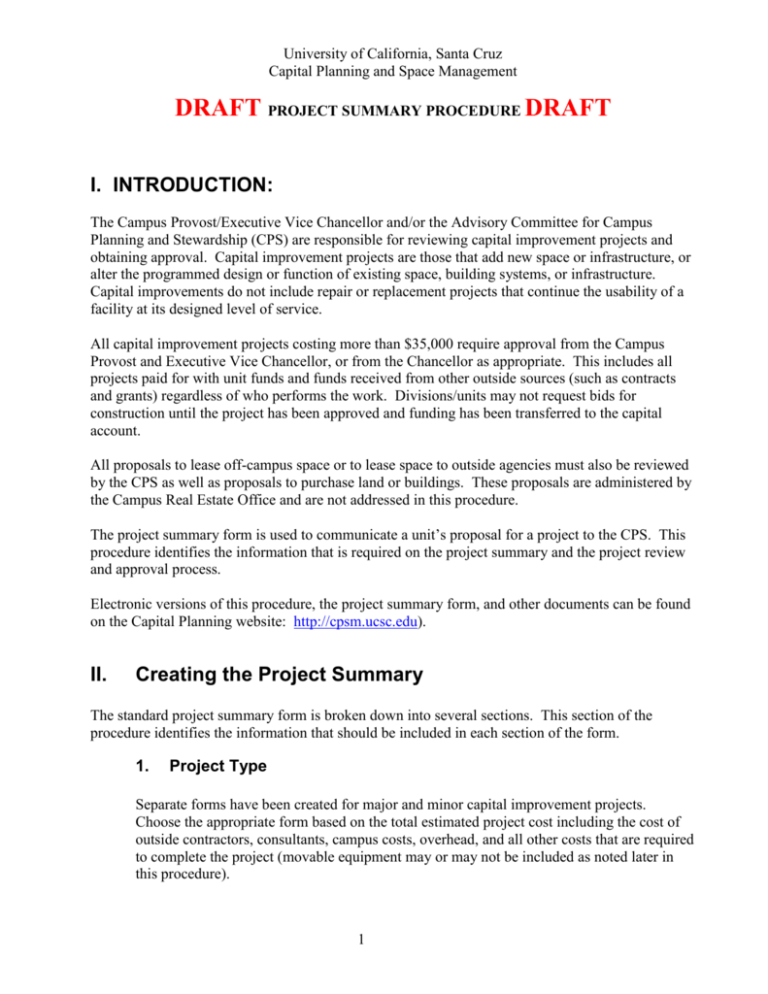
University of California, Santa Cruz Capital Planning and Space Management DRAFT PROJECT SUMMARY PROCEDURE DRAFT I. INTRODUCTION: The Campus Provost/Executive Vice Chancellor and/or the Advisory Committee for Campus Planning and Stewardship (CPS) are responsible for reviewing capital improvement projects and obtaining approval. Capital improvement projects are those that add new space or infrastructure, or alter the programmed design or function of existing space, building systems, or infrastructure. Capital improvements do not include repair or replacement projects that continue the usability of a facility at its designed level of service. All capital improvement projects costing more than $35,000 require approval from the Campus Provost and Executive Vice Chancellor, or from the Chancellor as appropriate. This includes all projects paid for with unit funds and funds received from other outside sources (such as contracts and grants) regardless of who performs the work. Divisions/units may not request bids for construction until the project has been approved and funding has been transferred to the capital account. All proposals to lease off-campus space or to lease space to outside agencies must also be reviewed by the CPS as well as proposals to purchase land or buildings. These proposals are administered by the Campus Real Estate Office and are not addressed in this procedure. The project summary form is used to communicate a unit’s proposal for a project to the CPS. This procedure identifies the information that is required on the project summary and the project review and approval process. Electronic versions of this procedure, the project summary form, and other documents can be found on the Capital Planning website: http://cpsm.ucsc.edu). II. Creating the Project Summary The standard project summary form is broken down into several sections. This section of the procedure identifies the information that should be included in each section of the form. 1. Project Type Separate forms have been created for major and minor capital improvement projects. Choose the appropriate form based on the total estimated project cost including the cost of outside contractors, consultants, campus costs, overhead, and all other costs that are required to complete the project (movable equipment may or may not be included as noted later in this procedure). 1 University of California, Santa Cruz Capital Planning and Space Management DRAFT PROJECT SUMMARY PROCEDURE DRAFT 2. Major Capital Improvement Project – A renovation or new construction project with a total project cost of $750,000 or more. Minor Capital Improvement Project – A renovation or new construction project with a total project cost of at least $35,000 but less than $750,000. Project Identification Enter the date the project summary is being prepared, the current budget year (20XX-XX), the project number (plant account 97XXXX or CFR number), and the project title. 3. Project Description and Justification The information included in this section of the form should be brief but complete so that the CPS, CP/EVC, Chancellor, and others reading the project summary have enough information to understand the project and its implications. The following information should be considered when completing this section of the form: The project description should include the details of the project (who, what, where, when, why, and how). o Identify the unit(s) proposing the project and other units that might be involved. o Document the unit(s) funding the project and the total amount allocated by each unit. Also identify any outside agencies providing funding and the amount provided by each agency. o Identify the total cost of the project. The cost of equipment and moving costs may or may not be considered a part of the project but should be identified within the text. o For construction projects identify the location including the building name and room number(s) according to the Facility Inventory (FacilitiesLink) and/or a description of the area if new construction is proposed. o Describe the scope of the project, what will occur during construction (utility shutdowns, hazardous materials abatement, etc.) and the Assignable Square Footage (ASF) affected. For renovation projects, identify the ASF before the renovation according to FacilitiesLink and estimate the ASF after the renovation. o Identify special maintenance requirements, the unit responsible for maintenance, and the unit responsible for maintenance costs. o Identify anticipated energy and utility use. o For major capital improvements, provide a list of sustainable measures being considered. o Identify construction beginning and end dates. For major capital improvements, identify the time frame for each phase of construction or attach a construction schedule to the project summary. o Identify all moves and temporary space needs associated with the project. 2 University of California, Santa Cruz Capital Planning and Space Management DRAFT PROJECT SUMMARY PROCEDURE DRAFT o Consider the history of any related projects. The project justification should not only identify why the project is needed, but also justify the cost. o Identify the planning process/assumptions that were used in developing the proposal and identify alternative solutions (if any). o How does the project affect the academic goals of the campus/division. o How does the project affect the campus’ space needs and/or facilities plan. o How does the project affect future projects and/or space decisions. NOTE: The project summary form should include all of the pre-printed information, through the Chancellor’s signature, on the face of the form. Pages may be added to continue describing and justifying the project. 4. Funding Source While the Project Description and Justification section identifies each unit/entity that will provide funding for a proposed project, the Funding Source section of the project summary identifies the specific account(s) and amount(s). This information is reviewed by Planning and Budget to confirm the account has the funds available for the proposed project. Include a brief description of the funding source under “Fund Name”. Only the Fund and Organization code is needed in the “Account” section; the full FOAPAL is not required. For each funding source, identify the amount provided. Calculate the total cost of the project. Additional lines may be added as required to identify all of the funding sources. If grant funds have been promised but not received, the project summary should identify the granting agency in the “Fund Name” section and leave the fund/org information blank. NOTE: Up to $100,000 in State operating funds (19900) may be used for minor capital improvements (less than $750,000). With few exceptions, State operating funds may not be used for major capital improvements ($750,000 or more). 5. Funding Schedule This section is required only for major capital improvement projects and is not included on the minor capital improvement form. A full Capital Improvement Budget (CIB) is required for all major capital improvement projects. Physical Planning and Construction (PP&C) and Capital Planning and Space Management work with the unit to identify campus costs, calculate the budget, and identify the breakdown that is entered into the Funding Schedule. 3 University of California, Santa Cruz Capital Planning and Space Management DRAFT PROJECT SUMMARY PROCEDURE DRAFT The cost of each phase of the project (preliminary plans, working drawings, and construction) must be identified. The line item for Equipment (Groups 2 & 3) includes only the cost of movable equipment. The total project cost identified in this section should match the total calculated in section 4. 6. LRDP Classification This item is required for major capital improvement projects and is not included on the minor capital improvement form. The EIC Form prepared by the Environmental Assessment Group will indicate whether the project is consistent with the most recent campus Long Range Development Plan (LRDP). When a project is not consistent with the current LRDP, a Regent’s Item must be created for The Regents to consider amending the LRDP. 7. EIC Form Attached An Environmental Impact Classification (EIC) identifies the environmental status of the proposed project and whether an Environmental Impact Report may be required. An EIC is required for all major capital improvement projects. The unit or the Physical Planning and Construction Project Manager are responsible for contacting the Environmental Assessment Group to determine whether an EIC Form is required for a minor capital improvement project. If so, the following language is required in the project description: “To comply with UC policy on the implementation of the California Environmental Quality Act (CEQA), an Environmental Impact Classification (EIC) form was used to determine whether the project is subject to CEQA and what form of environmental documentation was anticipated. The signed EIC is attached.” III. Project Summary Reviews Minor capital improvement project proposals may be reviewed internally and can be approved by the CP/EVC or Chancellor as soon as a complete project summary is available. Major capital improvement project proposals are reviewed internally and by the CPS before the project summary is recommended for approval. A proposed major capital improvement project could be in review for up to six weeks before approval is obtained. This section of the procedure identifies the timing and the review process. 1. Planning and Budget Review Draft major capital improvement project summaries must be submitted to Capital Planning and Space Management (CPSM) by the middle of the month. CPSM will circulate the final 4 University of California, Santa Cruz Capital Planning and Space Management DRAFT PROJECT SUMMARY PROCEDURE DRAFT draft for review by Physical Plant, EAG, PP&C, EH&S, and other campus entities as appropriate. All questions must be resolved and all required documents (signed EIC, CIB, project schedules, list of sustainable measures, etc.) must be complete and received by the end of the month to ensure the project is on the following month’s CPS agenda. Draft minor capital improvement project summaries normally are not reviewed by CPS and therefore these proposals may be submitted to CPSM at any time. After the internal review process, CPSM will forward the project summary directly to the CP/EVC and/or Chancellor for approval. The internal review and approval process normally takes about a week. 2. CPS Review The CPS generally meets on the third Tuesday of each month, but does not meet during the summer. Capital Planning and Space Management is responsible for creating and distributing the committee agenda one week prior to the meeting date. Major capital improvement project summary forms are attached to the agenda so that the committee members have an opportunity to review the proposal before the meeting. If the committee does not meet when a project is ready for review, Capital Planning and Space Management will forward the project to committee members for review via email. The CPS will make a determination as to whether a proposed project should be recommended for approval or if additional information is needed. Unit representatives may be asked to attend the CPS meeting to give a brief (five to ten minute) presentation and/or answer questions. 3. Chancellor’s Approval Once the CPS recommends a major capital improvement project for approval, Capital Planning and Space Management will forward the project summary to the Chancellor for review. Although the CPS may recommend approval of a proposal, the Chancellor may choose not to approve the project. 4. Approved Project Distribution Once a project is approved, the signed project summary is returned to Capital Planning and Space Management for processing. An electronic version of the signed project summary will be emailed to the unit representative, PP&C Project Manager, PP&C Business Manager, Plant Accounting, and others directly involved in the project. 5

